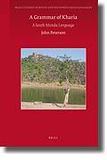A Grammar of Kharia
Peterson, John M.:
A Grammar of Kharia : a South Munda Language / John Peterson. - Leiden [u.a.] : Brill, 2011. - xxii, 474 S. - (Brill's Studies in South and Southwest Asian Languages ; 1)
ISBN 978-90-04-18720-7
EUR 152,00 / US$ 216,00
DDC: 495.95
Beschreibung
Kharia, spoken in central-eastern India, is a member of the southern branch of the Munda family, which forms the western branch of the Austro-Asiatic phylum, stretching from central India to Vietnam. The present study provides the most extensive description of Kharia to date and covers all major areas of the grammar. Of particular interest in the variety of Kharia described here, is that there is no evidence for assuming the existence of parts-of-speech, such as noun, adjective and verb. Rather functions such as reference, modification and predication are expressed by one of two syntactic structures, referred to here as “syntagmas”. The volume will be of equal interest to general linguists from the fields of typology, linguistic theory, areal linguistics, Munda linguistics as well as South Asianists in general. [Verlagsinformation]
Inhalt
List of Maps. xv
Acknowledgements. xvii
Abbreviations and Symbols. xxi
Abbreviations of Sources. xxiii
I. INTRODUCTION: THE KHARIA LANGUAGE. 1
1.1 General Introduction. 1
1.2 Genetic Affiliations. 7
1.3 Previous Studies on the Kharia and What this Study Adds. 8
1.4 Some Terminological Issues. 16
1.5 Kharia Orthography and the System of Transliteration used here. 19
1.6 The Structure of this Study. 24
II. PHONOLOGY. 27
2.1 Vowel Inventory. 27
2.2 Consonants. 29
2.3 Syllable Structure. 32
2.4 Morphophonology. 33
2.5 The Phonological Word. 35
2.6 Sentence Prosody. 46
III. SYNTACTIC ATOMS. 51
3.1 Clitics as "Phrasal Affixes". 51
3.2 Clitics in Kharia - An Overview of their Characterisics. 61
3.3 Affixes. 68
IV. PARTS OF SPEECH AND THE LEXICON. 71
4.1 Introduction and Methodology. 71
4.2 The "Precategoriality" of Simple Contentive Morphemes. 75
4.3 Derived Forms. 92
4.4 "NPs" as Verbs? Syntactic Categories, not Lexical Categories. 106
4.5 Parts of Speech in Kharia: A Summary. 116
4.6 "Compounds" and "Noun Incorporation". 118
4.7 "Echo-Words". 129
V. THE CASE-SYNTAGMA ("NPS"). 135
5.1 General Introduction. 135
5.2 Case. 143
5.3 Adpositions. 149
5.4 Number. 158
5.5 Inalienable Possession. 162
5.6 Proforms. 168
5.7 Interrogatives, Indefinites and Negative Indefinites. 178
5.8 Demonstratives. 182
5.9 Quantifiers and Classifiers. 187
5.10 Modification. 200
VI. THE TAM/PERSON-SYNTAGMA ("VERBS"). 209
6.1 General Introduction. 209
6.2 Person / Number / Honorific Marking. 212
6.3 Types of semantic bases in the Tam/Person-syntagma. 214
6.4 TAM / Basic Voice Marking. 239
6.5 "V2s" - Markers of the Passive / Reflexive and Aktionsart. 293
6.6 Partially Finite and Non-finite Forms. 313
6.7 Negation. 334
6.8 Periphrastic Tam/Person-syntagmas ("Verbs"). 341
6.9 Inference. 349
VII. SYNTAX. 351
7.1 Grammatical Relations. 351
7.2 Interrogatives. 368
7.3 Qualitative Predication - "Nominal" and "Copular" Sentences. 374
7.4 Clause Coordination. 388
7.5 Subordination. 389
7.6 "Relative Clauses" - Prepositional Attribution. 406
7.7 Information Structure - Topic, Focus and Constituent Order. 426
APPENDIX. Text: The nine Totems. 439
Bibliography. 453
General Index. 461
Index of Authors. 473
Autor
JOHN M. PETERSON, Ph.D. (1997) in Linguistics, University of Kiel, is a visiting professor of Linguistics at the University of Leipzig. He has published extensively on South Asian languages of both Munda and Indo-Aryan stock, including Grammatical Relations in Pāli and the Emergence of Ergativity in Indo-Aryan. Curriculum vitae.
Quellen: Brill; Amazon; WorldCat; Mitteilung in der Mailing-Liste "Indology", 24. März 2011.
Ähnlich
- Samuels: Colloquial Tibetan
- Abbi: A Grammar of the Great Andamanese Language
- Medieval Tibeto-Burman Languages IV
- Deutsch-tibetisches Wörterbuch
- A Grammar of the Thangmi Language
- Research Notes on the Zhangzhung Language
- Himalayan Languages and Linguistics
- Lexicon of Tibetan Verb Stems
- A Grammar and Dictionary of Zaiwa
- Mylius: Lehrbuch der Ardhamāgadhī

